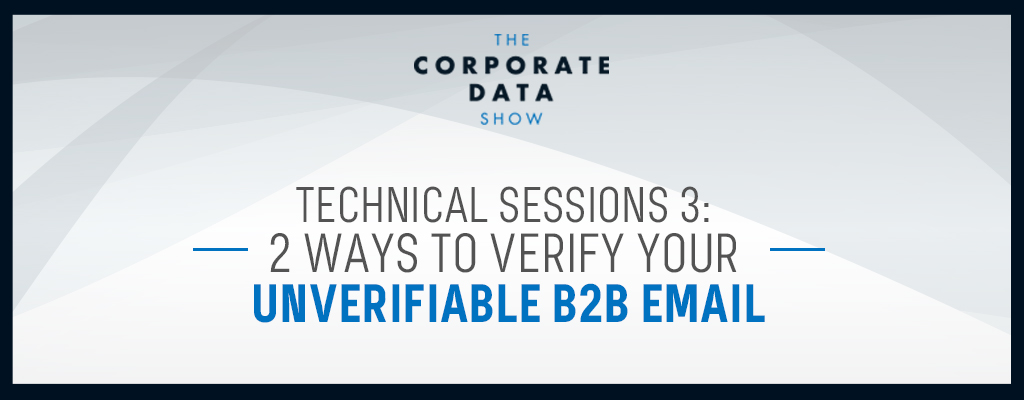
Technical Sessions 3: 2 Ways to Verify Your Unverifiable B2B Email
It’s been a problem for a long time for a lot of companies: unverifiable B2B email addresses. Especially if you’re a marketing company or department with a big pile of data, you end up with a bunch of question marks instead of valid data.
Welcome back to the Corporate Data Show’s third Technical Sessions, the place where you can find a short guide series translating technical data processes to real world marketing applications.

Q: What are the two methods of root validation of unverifiable B2B email addresses?
A: Sent mail and “ask” (a.k.a. pings, MX lookups, and port 80 asks). Each method has its pros and cons, which Rick Holmes, founder of Every Market Media, is here to explain.

Pros: Sent Mail
Sent mail—meaning email, not direct mail—is one of the highest quality ways to ensure your messages are being delivered to a person.
“With a good delivery system, responses to sent mail can be trusted,” Holmes said. A delivery message, especially with an open, is a great way to check to be sure that a person got your message.
A problem with sent mail (coming up later) is that catch-alls can keep the message from being delivered. But if you have great delivery, you’re not likely being spoofed. (Plus, you can collect more metadata this way.)
Another pro of good delivery is the low percentage of unknown responses. “Your soft bounces, mailbox full notifications, and out of office responses also come in much smaller amounts,” Holmes said. The quality is just higher because you can draw a direct line between your message and the recipient.
Say you need to verify a couple hundred thousand B2B email addresses. With good deliverability, it’s always cost effective at scale (provided your data isn’t dirty). Sending off a high quality server is going to give you some nice indication of the identity of the unverifiable B2B email.
“One of the things we use to test our delivery segments is ISP mailboxes,” Holmes said. “They tend to give us a good indication of whether or not we’ll deliver. If you’re sending to a Gmail box you can pretty much trust the response because they’re the name for inboxing.”\
Basically, sent mail builds domain-level intelligence that can be used to improve synergy with ask results. Insider tip: If you can get an ask response and a sent mail response, it’s all going to work way better.

“Use ask and sent mail as a group if you want to be able to balance the cons of each with the pros of each.” –Rick Holmes"
Pros: Ask
The ask is on the back end on most live verification. So, a solution to unverifiable B2B email addresses is not to send actual mail (because sent mail has to have an offer, which means it’s got to be CAN-SPAM compliant). To save time, the popular and inexpensive method of ask has come along.
Good news! It’s fast. If a server responds, it doesn’t take long.
It’s also cost-effective. Ask is way less cumbersome in time and effort. When you just ping a record rather than deal with a message, you can find out whether you want to bother with sent mail at all.
Ask is great for applications where overcutting doesn’t matter. “If a marketing company needs to glean 5,000 records from a 100,000 record database, ask is your solution,” Holmes said. “That many unverifiable B2B emails is a giant waste of time, so you just ping 25,000, throw away the unknowns, and give the rest successful passes.”
Not only does ask help you send smarter mail on the sent mail side, it works really well with SOHO (ISP) type emails with established ask response rules. “Ping works freaking awesome on B2C data,” Holmes said, “because in ISPs where Gmail is providing a free server, they’ve built the standard for what a response looks like.” You’re either going to be allowed into verifying a Gmail address or you’re not.
Cons: Sent Mail
And here’s the six-point cloud the sent mail silver lining goes around.- Low sending reputation. When you’re sending mail with a low quality sending solution, you risk getting a lot of soft bounces and ambiguous responses from the server. This decreases your reputation, which means you will get less actual delivery signal and less actual bounce signal.
- Awful first clean solution. Too much sent mail based on dirty data will ruin the equipment you’re sending on, and your sending reputation will go right into the floor. Even if you have a low quality or cheap server that you don’t mind completely fragging, sent mail is still going to wreck the server really, really fast.
- Scaling issues. Unless you have a tremendously diverse set of offers you can send at high volume on diverse delivery equipment, eventually your mail is going to end up in the spam filter at best and get rejected before delivery at worst. Sending 20 million messages to unverifiable B2B emails is just not viable, and that’s not even considering response rates, offer rotation, or anything else.
- Catch-alls. When your sending reputation is bad, you will send to a catch-all domain where they will not often choose to deliver you because domains set up as catch-alls get a ton of mail. And even if you have a good reputation and they do deliver, you might successfully deliver to a trap—and that’s really bad.
- Slow. Sending 20 million messages at a decent delivery rate with offer rotations can take months.
- Server response variance. There’s not a standard guide for email administrators for how to set up for error codes. So if you ping a highly sought after account in B2B, they could send you back an error code in a different language, and you could potentially dump useful info out of your database based on a varied server response.
Cons: Ask
If you own a bunch of domains whose whole purpose is to ask a whole bunch of other domains if certain addresses accept mail, that consumes server resources. To a certain extent ask is now starting to be spoofed or not responded to by domains that choose not to use resources for it.
A big con of pinging is high profile people and domains could send you back a jargon response that will appear to be a bad record. At certain domains, IT departments are choosing to cut down on spam using methods like that, so the ping isn’t always trustworthy.
“If you’re looking for a fast cut and you’ve got more data than you need, use a ping. If you need to keep every record and you’ve got the time and you want the best possible remaining data, you want to go with mail.” –Rick Holmes
Nonresponses are even more common, when a server refuses to spend resources responding to your request. Neither do catch-all responses confirm a person exists (the same challenge of sent mail). “If it delivers or is given its own bucketed response, that doesn’t help us know if there’s a person on the other end,” Holmes said. “It could be a trap or harmful to your reputation, so you exclude it.”
High removal and low sending reputation are equal cons in ask as in sent mail. Inefficient handling could cut half your data out, and that’s unacceptable to B2B marketers trying to market at an account-based level.
Q: So, which method is best?
A: Trick question.
“If you’re looking for a fast cut and you’ve got more data than you need, use a ping,” Holmes said. “If you need to keep every record and you’ve got the time and you want the best possible remaining data, you want to go with mail. If you want a hybrid solution like we do, we think the best method is both methods.
“I don’t think either method is great as a standalone, especially if you’re talking about verifying millions of records. Use ask and sent mail as a group if you want to be able to balance the cons of each with the pros of each.”
At Every Market Media, we’re looking forward to better catch-all resolution. Our plan towards the end of this build cycle is to address catch-alls in a completely new way so we can do more sent mails and better interpret responses.
That’s the podcast! Responses welcome, especially if you’re interested in more Technical Sessions including guests.


